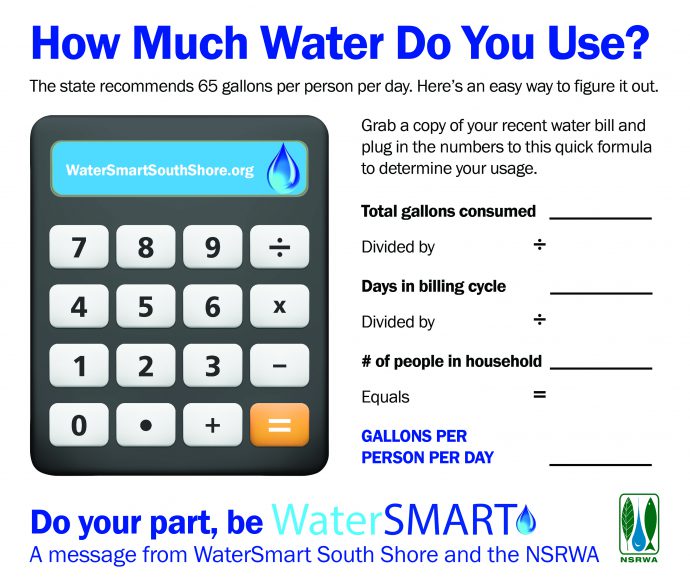
By Steven Reitz, NSRWA Intern
The students on the South Shore participate in the Water All Around You program thanks to the support of 12 towns and the NSRWA WaterSmart program. In this program they learn about our water resources and how to keep our water clean and plentiful. While it’s great to educate the kids for the future while they are still young, how do we get the message to the adults for today’s problems?
Nearly every parent volunteer, as well as many of the teachers and educators participating, walk away astounded at just how much water we go through as a society and how we take it for granted every day. Nonbelievers may argue against the idea that water is scarce, considering more than 70 percent of our world is water and growing, but it may come to surprise you that less than one percent of this water is fresh and usable! Often times our parent volunteers suggest that we should offer the Water All Around You program to adults to educate them on the current water issues we face. Unfortunately, today’s hustle-and-bustle world has made it difficult to organize a large sum of adults together, especially considering those that would be interested in attending are likely to be privy to the information we are trying to communicate. The internet has, however, made it easier to get this message across to the masses at their leisure.
Did you know that Massachusetts recommends no more than 65 gallons of water be used per person per day? Sixty-five gallons may be a lot of water, but when you start realizing just how much you use during your daily activities, it tends to add up very quickly. For example, if you were to water a one-acre yard with one-inch of water, it would consume 26,000 gallons of water, the size of a 16’ X 32’ pool! If you are interested in knowing how much water you and your family consume, grab a copy of your recent water bill and plug in the numbers to this quick formula to determine your usage:
Total gallons Days in # of people in = GALLONS PER PERSON PER DAY
consumed billing cycle household
___________ ÷ ___________ ÷ ____________ = _____________
NOTE: If your water bill is in cubic feet (CF), multiply your consumption in cubic feet by 7.48 to convert to gallons, and then make the same calculation above. If your consumption is in hundreds of cubic feet (CCF), then multiply by 748 and follow the calculation.
While we may be in a water-rich region of the world, it does not excuse us from having to take responsibility to ensure we have enough water to sustain our ever-growing population, nor does it mean we will not come to rely more heavily on the ground water we are already chipping away at. While the message may seem scary, there are many ways we can improve our behaviors as we undergo our daily activities. Below is a table of everyday activities and how you can improve on saving water, which is not only good for the environment but your wallet as well!
| Activity |
Water Wasters |
Water Savers |
How to minimize waste |
| Shower |
17 |
10 |
Take shorter showers (no more than 5 minutes) |
| Bath |
24 |
12 |
Use less water when filling the tub |
|
Toilet |
20 |
10 |
Invest in an energy-efficient toilet |
|
Sink (Bathroom) |
2 |
1 |
Turn the water off while brushing teeth |
| Drinking |
1 |
1 |
N/A |
|
Sink (Kitchen) |
10 |
3 |
Don’t let water run while washing dishes |
|
Dishwasher |
12 |
6 |
Invest in an energy-efficient machine |
| Lawn Watering |
120 |
0 |
Invest in a rain barrel or water during dawn/dusk |
| Car Washing |
100 |
45 |
Go to an environmentally-friendly car wash |
What is WaterSmart?
Being WaterSmart is a new way of thinking about our water resources and helping to ensure that our water is clean and plentiful for generations to come. Water is a valuable resource, especially here on the South Shore, so it’s important to use it wisely. Conserving water or using it efficiently, as well as controlling pollution, will help ensure it is available for people, plants and animals now and in the future. Whether it is in our homes, our businesses or on our streets, we can all do our part to help keep our water clean and plentiful.
The WaterSmart Program is a partnership with the NSRWA and 11 towns on the South Shore; Aquarion (Hingham and Hull), Duxbury, Hanover, Hingham, Kingston, Marshfield, Norwell, Pembroke, Scituate and Weymouth, which provides education to school children and adults on water conservation in their homes, businesses and towns.
For more information about WaterSmart, contact the program manager, Lori Wolfe, at lori@nsrwa.org or (781) 659-8168.
